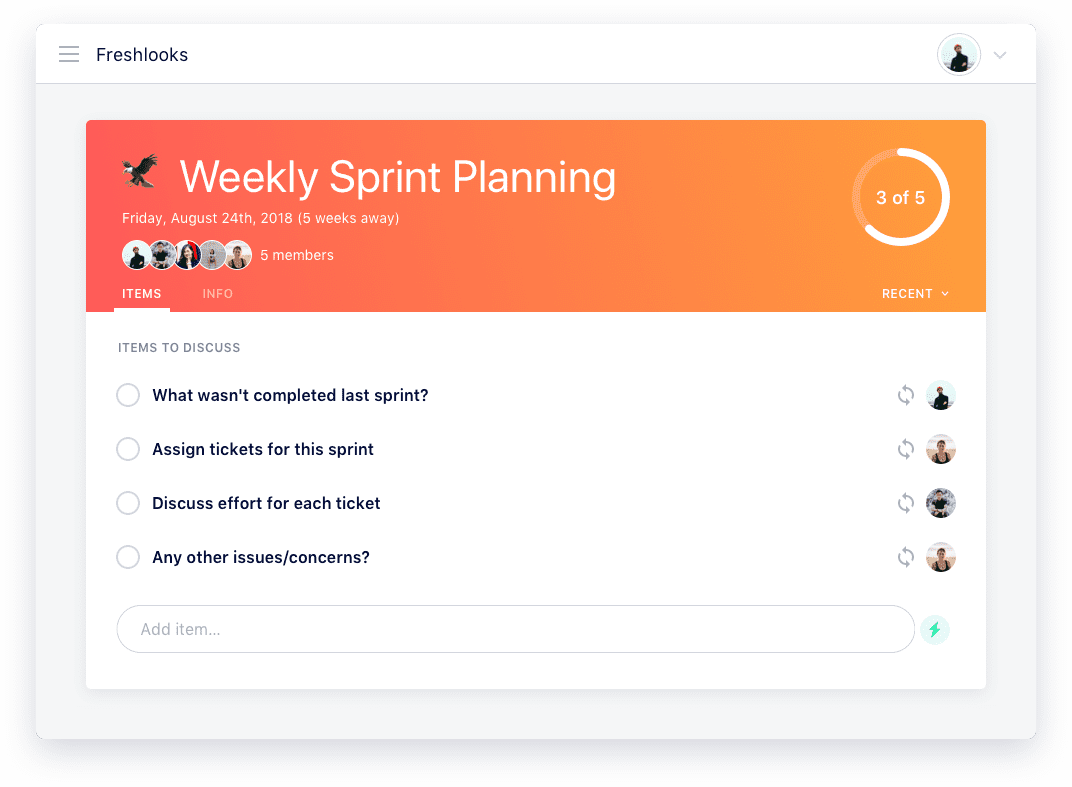How to create a sprint planning agenda
Here at Hypercontext, we use sprint planning to boost communication and productivity across the team. Particularly for our engineering team…
Warning: Undefined array key "category" in /www/hypercontext_216/public/wp-content/themes/Soapbox/hype-files/sections/article/content.php on line 10
Here at Hypercontext, we use sprint planning to boost communication and productivity across the team. Particularly for our engineering team – headed up by our Director of Engineering Scott Spencer – the sprint planning meeting is a crucial step in staying organized and on-task for the two weeks ahead. 📆
A quick backgrounder: our engineers use story points to plan their upcoming sprint. Each story point is about a day of work, and each engineer is assigned eight story points of work to complete over the next two-week sprint. That’s what a sprint planning meeting is all about: divvying out those points. “The goal is that everyone walks out knowing exactly what’s expected of them for the next sprint,” says Scott.
This might be old news for some, but what exactly should happen at a sprint planning meeting? 🤔 What should be on the sprint planning agenda? We asked Scott for some expert intel on what to include.
Here are four items to include on your sprint planning agenda. (Click here to jump to our actual sprint planning agenda!)
1. What wasn’t completed last sprint?
Before you can get to new tickets, you need to take stock of outstanding items from the previous sprint. Go around the table and find out what tickets weren’t completed. For each of those, how much of the ticket was completed? If it was originally estimated at two story points, is it now down to one?
This step is about holding your team accountable: harvesting all outstanding points to ensure they’re taken into account when assigning points for the next sprint.
2. Assign tickets for this sprint
Once you have a sense of what needs to be carried over from last sprint, you can move in some new tickets for this sprint and assign them to your team members. If your team is working on ongoing projects, this might be a fairly straightforward process, because the next steps are clear.
What’s really important at this point in the meeting is that as a team, you clarify what “done” looks like for each ticket. And this is what Scott says is one of the biggest challenges around sprint planning meetings: communicating.
“Things can be repetitive,” he says. “Your team can get used to things.” In other words, your team says “I know what you mean,” and you take for granted that they mean it. “Then, two months later, you find that things are slipping a bit.”
So you need to make sure that things are being talked about, again and again: what does each ticket entail? What does done really look like on this ticket? Reiterate it every single time, so that you don’t risk a miscommunication.
3. Discuss effort for each ticket
The next step is assigning the tickets, and getting a sense of the effort behind each one. This is where story points come in again: how many points should be assigned to each ticket?
Scott recommends getting an estimate from the person assigned to the ticket, but also from everyone else on the team – even if they’re not involved with the project. “It gives you insight into what they think it will take to finish it,” he says. “That opens up a good conversation about expectations.”
For example, if everyone thinks a ticket will take three story points, and one person thinks it should take one story point, you can discuss why they think it will take less time. Do they know a faster way to complete the project? Or are they unaware of some of the steps required?
Going through this process for every ticket is also a great way to keep everyone vigilant about taking into account every part of a ticket. People often forget about code review, for example, or they don’t assign enough time for it. But estimating every ticket as a group encourages them to think the ticket through from start to finish.
Once you’ve assigned story points for each ticket, you can fine-tune your assignments to ensure everyone has the appropriate number of points for the sprint ahead.
4. Any other issues/concerns?
This is the final step in getting buy-in from everyone about the sprint to come: are there any roadblocks they see impacting the sprint? Any outstanding questions?
“This is what they’re doing for the next two weeks,” says Scott. “So they all need to speak now if they have any concerns.”
Scott’s biggest piece of advice when setting up a sprint planning meeting: as the leader, know the work you’re going to be talking about beforehand. He does sprint planning with his team every other Friday. So the Thursday before, he sits down with our CTO to see where things are at, and essentially pre-plan the sprint ahead.
“We plan a dream sprint where we get everything done,” he says. That’s what he brings into the sprint planning meeting, and then tweaks as needed as he gets insights and updates from the team.
“You can hit the ground running.” And who doesn’t want that?
Use Hypercontext for your sprint planning meetings
What you should do next
Now that you've read this article, here are some things you should do:
- We have a massive (& free) collection of meeting agenda templates all designed to help you run more effective meetings.
- You should try Spinach to see how it can help you run a high performing org.
- If you found this article helpful, please share it with others on Linkedin or X (Twitter)

